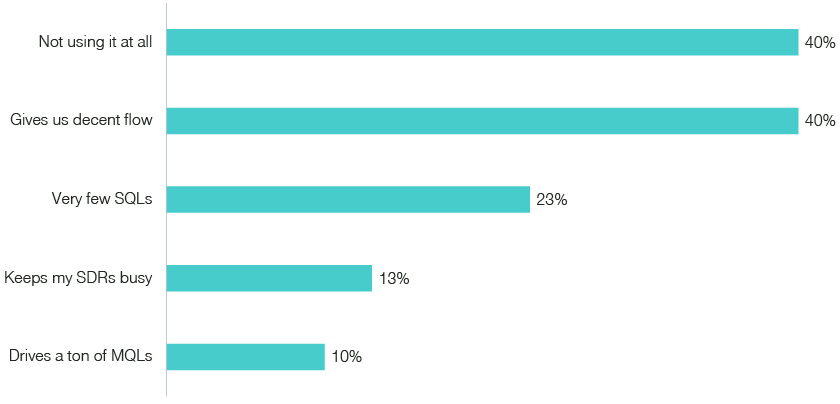When faced with softening demand, business leaders turn to a number of tools and levers. Foremost on that list is typically cutting costs, reducing price, or trimming the product portfolio. Simon-Kucher’s recent survey of revenue operations leaders revealed that one of the most powerful tools in the modern commercial toolbox, marketing automation, is being largely overlooked.
We asked these leaders what kind of lead generation results they were getting out of marketing automation and 40% responded that they “weren’t using it at all”. Another 18% couldn’t name the platform their company was using.

By now, we have all heard the maxim that half of today’s buying process has been completed before a sales representative ever talks to a customer. That means most companies are missing the opportunity to identify, educate, and influence buyers in the early stages of a buyer’s journey. Not only is this not sound marketing, but it is missing out on a critical opportunity in a down market - to inexpensively fill the sales pipeline with likely purchasers.
When analyzing the sales funnel of your organization and individual reps, it’s important to look at volume, shape, and length. Marketing automation can make all dimensions look healthier.
Case study: Improving lead quality and sales effectiveness through marketing automation
Our client’s sales funnel was lagging, with approximately 1.5 times revenue plan in the pipeline, insufficient win rates, and too many days in the Target/Prospect stage for too few opportunities. Compared to a healthy pipeline benchmark of 3 times revenue plan, they needed to make some changes to boost lagging rep performance.

They took the time to set up a marketing automation platform that was included as part of their CRM license but previously overlooked. Building on some fundamental steps, the marketing and sales leadership increased support for the sales force with better qualified leads and shorter sales cycles.
7 steps to increase leadflow
1. Build a common vocabulary around lead stages and set goals for the organization.
There are four main stages that begin “above the funnel”:
Information Qualified Leads (IQLs) – Individuals who match the demographics of target buyers within target segments.
Marketing Qualified Leads (MQLs) –IQLs who have engaged with your company by attending events, opening e-mails, following on social media, or visiting the website.
Sales Accepted Leads (SALs) –MQLs that have been passed to a sales rep who reviews the supporting details and agrees this is worth valuable selling time to qualify.
Sales Qualified Leads (SQLs) –SALs that have had a personal conversation with a SDR or sales rep and have the budget, authority, need, and time requirement (BANT) to purchase an offering.
2. Fill your database.
Depending on the data privacy regulations within your markets, buyer contact information can be purchased from list services. It is always a good practice to obtain consent from these contacts and legally required for current customers and prospects in many countries.
3. Document your buyer personas.
Perform voice of the customer (VOC) research to understand the responsibilities, goals, anxieties, and buying criteria of your IQLs. Outline the buyer’s journey as it moves from awareness to consideration to purchase to usage to loyalty to (hopefully) advocacy. Understand the needs and requirements for education at each stage to support development of content that will help accelerate the buyer’s movement through this journey in a posture that favors your organization.

4. Build nurture paths in your marketing automation platform.
Develop and sequence content along parallel process flows that supports and reacts to buyer decisions and responses along the journey. Set timing between outreach to be frequent enough to stay top of mind, but not so frequently that your IQLs unsubscribe in droves.
5. Develop content.
Use a mix of e-mails, videos, webcasts, social media posts, and events to present frequent opportunities for your IQLs to consume information, engage with your organization, and strengthen their awareness, interest, and consideration.
6. Develop the right lead scoring model.
Too many points for too few activities and a low bar for MQLs can flood the pipeline with poorly qualified leads, a situation that can be quite damaging to the commercial team. Refine the model based on closed loop feedback from the sales team.
7. Analyze and report results.
Understand where winning leads are coming from and which content is most frequently consumed. Use this information to continuously improve customer segmentation and the content library.
This is the reality of post-Covid demand generation in both B2B and B2C markets. The right content and nurture paths can build the value of your brand virtually by positioning your offerings and solutions versus commodities in the eyes of buyers who have real needs and substantial budgets.
Simon-Kucher has surveyed sales reps who state that “corporate generated MQLs are a waste of their time” when marketing doesn’t truly understand the company’s offerings, customer preferences, or IQL list quality. Getting it right typically requires a collaborative bridge to be established between sales operations and marketing operations, but these obstacles are surmountable.
If your organization has not already embarked on this effort to fill the sales pipeline with quality leads, let Simon-Kucher help get you started on the right foot.








